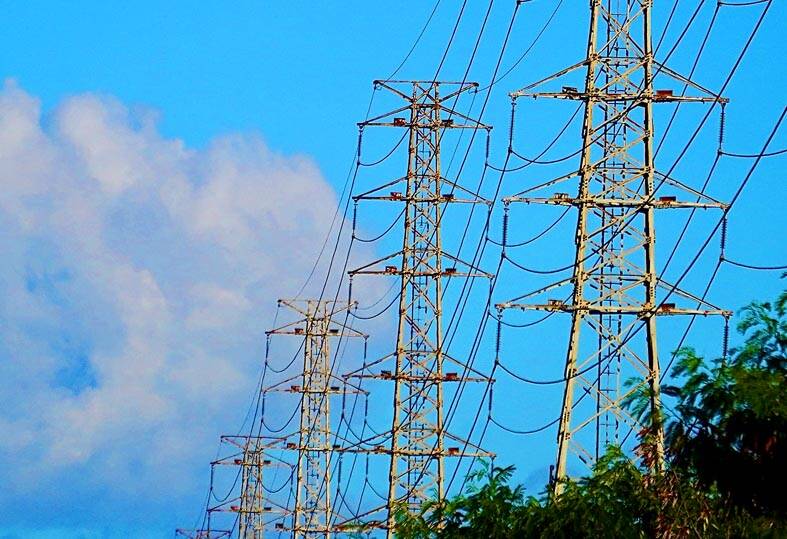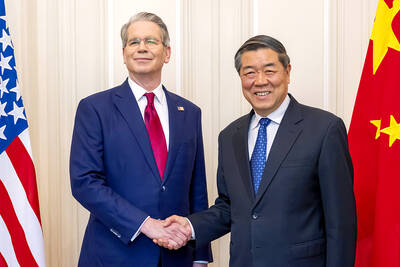The Electric Prosperity Index (EPI) released yesterday by the Taiwan Research Institute showed that the nation’s power consumption and economic activity for last month had slightly cooled from June.
The data came as industrial high voltage electricity consumption last month increased 0.34 percent year-on-year, indicating a “warming” economy, in contrast to June’s “booming” signal, the institute said.
The institute also predicted that Taiwan’s economy expanded 3.5 percent year-on-year last month.

Photo: CNA
The institute uses a five-color system to gauge Taiwan’s power consumption and economic activity, with “red” indicating “booming,” “yellow-red” signaling warming, “green” representing stable growth, “yellow-blue” signifying a sluggish economy and “blue” implying an economic contraction.
The overall manufacturing sector’s electricity consumption increased 0.77 percent last month, with the EPI slowing from red to yellow-red, the institute said.
Industry-wise, the semiconductor sectors’ electricity consumption grew 11.01 percent, the highest growth over the past three years, signaling the fourth consecutive month of a booming economy, it said.
That reflected high demand for artificial intelligence (AI) servers and advanced process applications, it said.
Also boosted by AI application demand, the computer, electrical and optical products industry saw its electricity usage increase 6.07 percent, continuing its yellow-red signal from the previous month, it said.
However, the chemical materials industry was blue, with electricity consumption falling 5.3 percent, which the institute attributed to surplus supply from China’s petrochemical industry, falling global oil prices, low-priced international competition, a slowing global economy and US tariff policies.
Meanwhile, electricity usage in the steel industry also contracted, falling 9.55 percent, the institute said.
While front-loading ahead of the US tariffs provided temporary benefits to local manufacturers, its effect would gradually diminish as businesses adjust their stocking and shipping schedules, it said.
As a result, electricity usage is forecast to normalize in line with slowing economic growth in the third quarter, it added.

Jensen Huang (黃仁勳), founder and CEO of US-based artificial intelligence chip designer Nvidia Corp and Taiwan Semiconductor Manufacturing Co (TSMC, 台積電) on Friday celebrated the first Nvidia Blackwell wafer produced on US soil. Huang visited TSMC’s advanced wafer fab in the US state of Arizona and joined the Taiwanese chipmaker’s executives to witness the efforts to “build the infrastructure that powers the world’s AI factories, right here in America,” Nvidia said in a statement. At the event, Huang joined Y.L. Wang (王英郎), vice president of operations at TSMC, in signing their names on the Blackwell wafer to

France cannot afford to ignore the third credit-rating reduction in less than a year, French Minister of Finance Roland Lescure said. “Three agencies have downgraded us and we can’t ignore this cloud,” he told Franceinfo on Saturday, speaking just hours after S&P lowered his country’s credit rating to “A+” from “AA-” in an unscheduled move. “Fundamentally, it’s an additional cloud to a weather forecast that was already pretty gray. It’s a call for lucidity and responsibility,” he said, adding that this is “a call to be serious.” The credit assessor’s move means France has lost its double-A rating at two of the

AI BOOST: Although Taiwan’s reliance on Chinese rare earth elements is limited, it could face indirect impacts from supply issues and price volatility, an economist said DBS Bank Ltd (星展銀行) has sharply raised its forecast for Taiwan’s economic growth this year to 5.6 percent, citing stronger-than-expected exports and investment linked to artificial intelligence (AI), as it said that the current momentum could peak soon. The acceleration of the global AI race has fueled a surge in Taiwan’s AI-related capital spending and exports of information and communications technology (ICT) products, which have been key drivers of growth this year. “We have revised our GDP forecast for Taiwan upward to 5.6 percent from 4 percent, an upgrade that mainly reflects stronger-than-expected AI-related exports and investment in the third

RARE EARTHS: The call between the US Treasury Secretary and his Chinese counterpart came as Washington sought to rally G7 partners in response to China’s export controls China and the US on Saturday agreed to conduct another round of trade negotiations in the coming week, as the world’s two biggest economies seek to avoid another damaging tit-for-tat tariff battle. Beijing last week announced sweeping controls on the critical rare earths industry, prompting US President Donald Trump to threaten 100 percent tariffs on imports from China in retaliation. Trump had also threatened to cancel his expected meeting with Chinese President Xi Jinping (習近平) in South Korea later this month on the sidelines of the APEC summit. In the latest indication of efforts to resolve their dispute, Chinese state media reported that